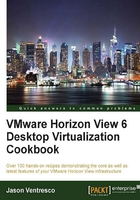
Analyzing our Horizon with View environment
Measuring the resource requirements of our physical desktops and their users is a valuable exercise that will help us understand what will be required to transition them from the local desktop to the data center. While this is a valuable exercise, no amount of initial planning or analysis can ever replace a properly run pilot that validates the configuration of our master virtual desktop image, the performance of the Horizon View infrastructure, and the perceived end user experience.
How it works…
Ideally, our pilot should involve the same types of users on whom we performed our initial usage analysis but not necessarily the same users within each group. The following list includes a sample of the goals that our Horizon View pilot should attempt to achieve:
- Include multiple users from each user classification such as the task worker, knowledge worker, and power user
- Include fully remote users, including WAN-connected users at other company sites
- Run the pilot for the full duration of a business cycle so that recurring operations such as quarterly reporting or accounting functions can be observed
- Review the performance data from all layers of the Horizon View infrastructure including:
- Storage
- Network
- vSphere host
- Guest operating system
- Measure the impact of common scenarios such as:
- User logon storms: These are large numbers of Horizon View clients logging on within a short time frame
- Steady state user load: This measures the Horizon View infrastructure's performance during a period of steady desktop usage by a significant number of users
- Antivirus platform performance: This measures the impact of common antivirus software tasks such as on-demand scans and pattern file updates
- Horizon View Refresh or Recompose: This measures the impact of these common Horizon View maintenance operations
- A fully populated vSphere host: This measures the host performance with higher than normal workloads, such as when a vSphere server fails, and the remaining vSphere servers must host its desktops in addition to their own
Performance issues at any layer of the Horizon View infrastructure will often result in a poor end user experience, usually in the form of longer-than-anticipated response times. This is one of the reasons why it is important to involve a large cross-section of our users in the pilot and seek their opinion throughout.
The performance data that we collect during the pilot can be used to determine our actual resource utilization, which can then be compared to the estimated resource utilization, as determined from our initial analysis of existing physical desktops. If the numbers differ by a significant amount, we will want to work to identify the cause and determine what would happen if any changes need to be made. Some potential issues that need to be looked out for include the following:
- The initial analysis of our users did not include a sufficient number or wide enough cross-section of users.
- The virtual desktop's master image was not properly optimized to reduce or stabilize the resource utilization. The VMware Optimization Guide for Windows 7 and Windows 8 Virtual Desktops in Horizon with View (http://www.vmware.com/resources/techresources/10157) technical paper provides common Windows desktop optimization techniques.
- A component of the Horizon View infrastructure was improperly configured.
- The pilot program is occurring during a period of higher than normal user workload, such as a recurring events unique to the organization, including quarterly or monthly reporting.